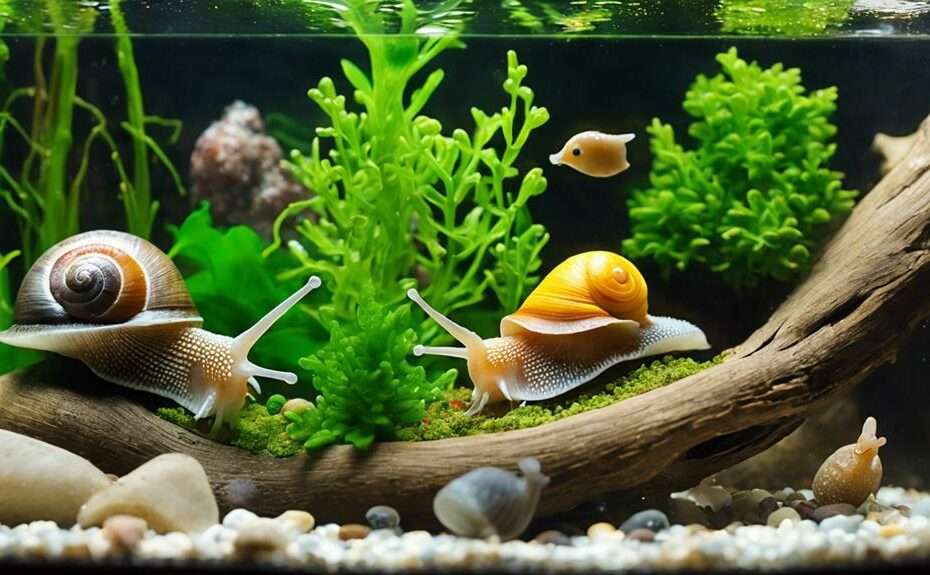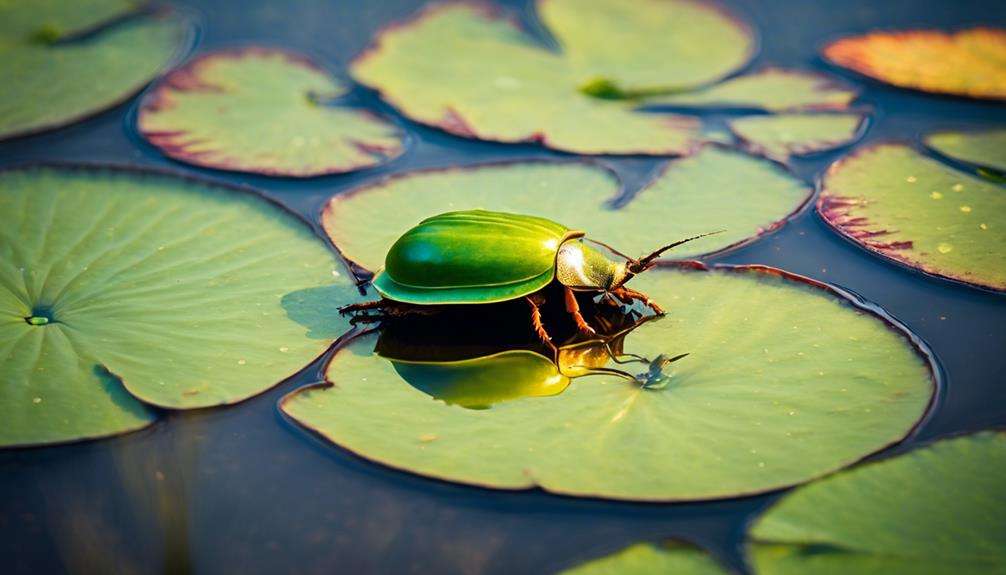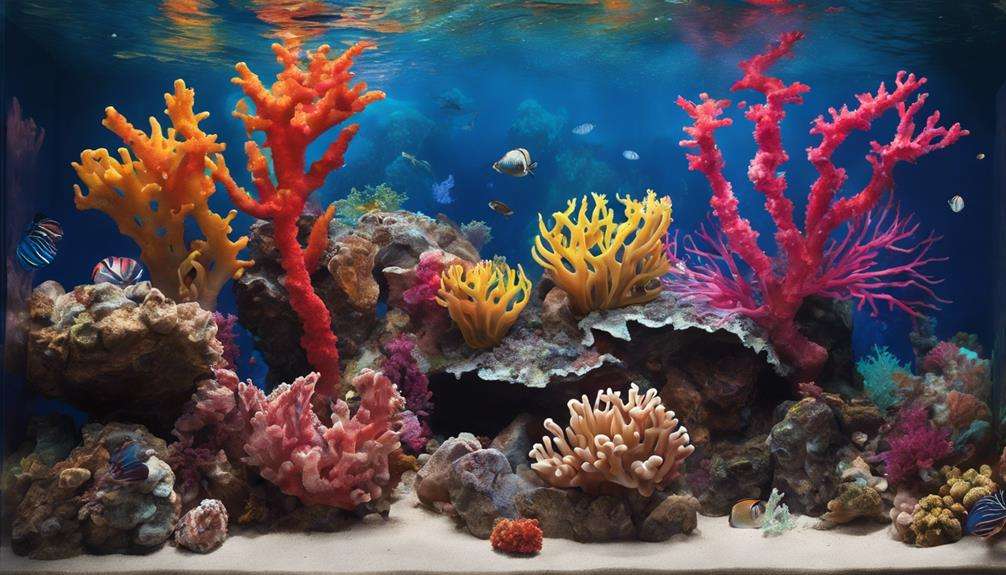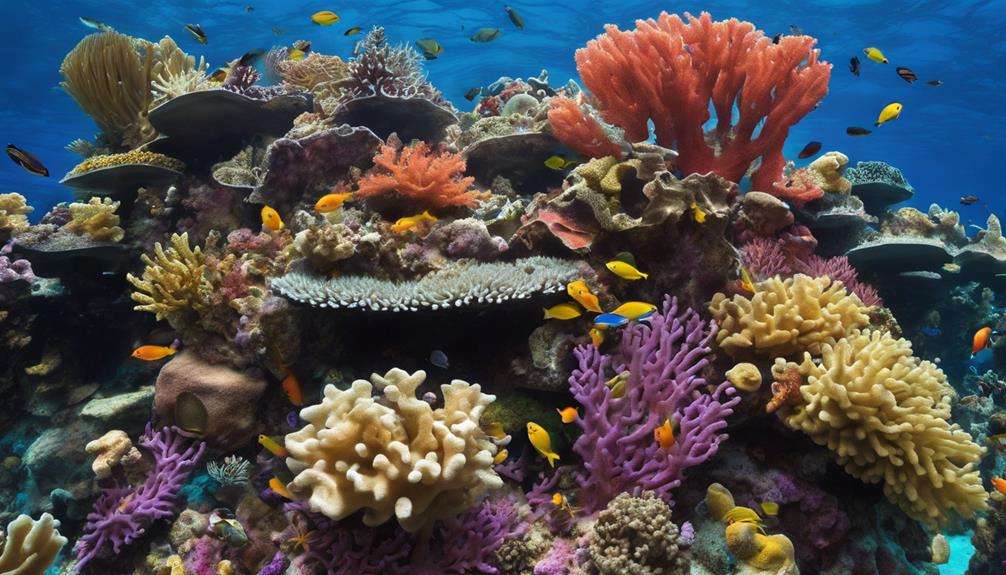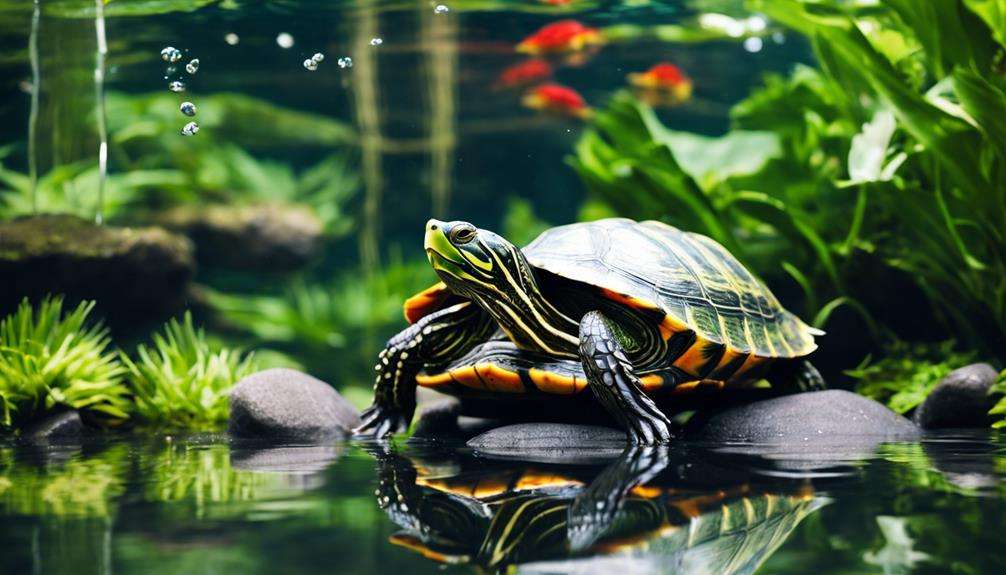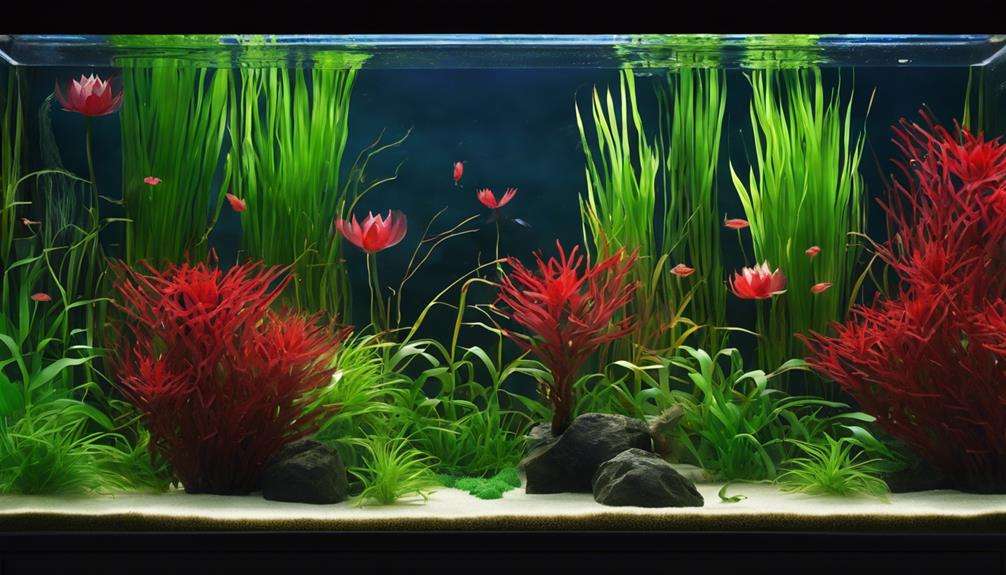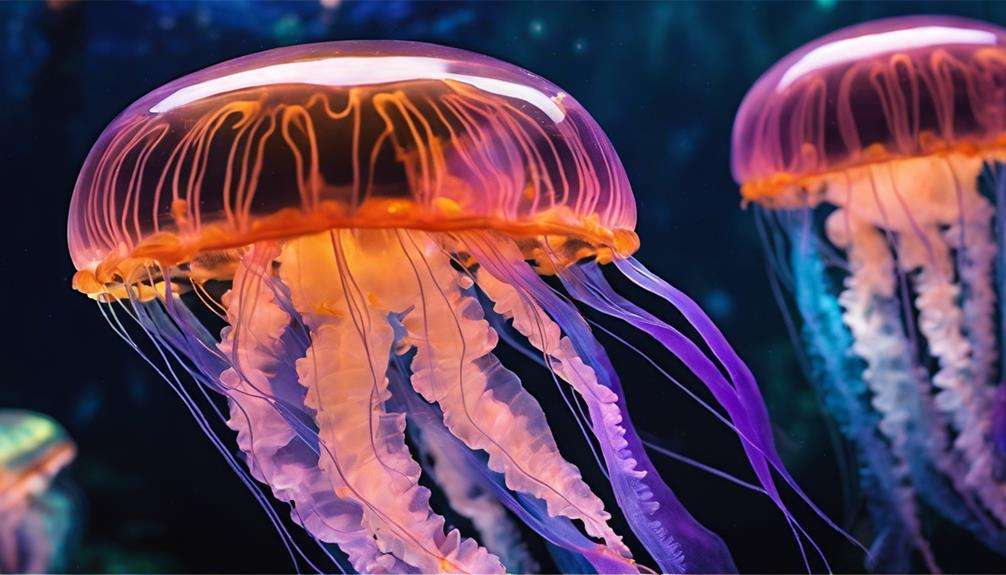If you've ever considered adding aquatic snails to your pet collection, you must be aware of the intricacies involved in their care. From selecting the right type of snail to ensuring a suitable environment, there are several key factors to keep in mind.
However, the most important aspect that often determines the well-being of these fascinating creatures is something you might not have thought about at first glance. By paying attention to this often overlooked element, you can greatly enhance your success in keeping aquatic snails as pets.
Key Takeaways
- Choose the right snail based on tank size and compatibility.
- Create a suitable habitat with hiding spots and stable water conditions.
- Opt for safe decor and substrate choices for a snail-friendly environment.
- Provide a balanced diet, monitor health, and maintain water quality diligently.
Choosing the Right Aquatic Snail
When selecting an aquatic snail for your tank, consider the tank size and compatibility with other tank inhabitants as essential factors. Different species of aquatic snails have varying care requirements, so it's important to research and choose the one that best fits your tank's conditions.
Look for healthy signs such as active movement, intact shells, and vibrant coloring. Avoid snails that exhibit signs of illness, parasites, or physical damage, as they can introduce problems into your ecosystem.
Ensuring the compatibility of the aquatic snail with other tank inhabitants is important for maintaining a harmonious environment. Some snails may consume certain plants or disrupt the balance within the tank.
Selecting the right aquatic snail that complements your tank's ecosystem not only enhances the overall aesthetics but also contributes positively to its maintenance. By considering these factors, you can create a balanced and thriving aquatic environment for your snails and other tank inhabitants.
Setting Up the Ideal Habitat
When setting up the ideal habitat for your aquatic snails, consider a tank size of at least 5 gallons to make ample space for their well-being.
Incorporate hiding spots, live plants, and a suitable substrate to mimic their natural environment and provide comfort.
Remember to maintain stable water conditions with temperatures between 65-83°F and pH levels of 7-8 for the best health of your aquatic snails.
Tank Size Consideration
To set up the ideal habitat for your aquatic snail, carefully consider choosing an aquarium size of at least 5 gallons for a single freshwater snail. Adequate tank size guarantees ample water volume for your snail to thrive.
For multiple small snails or Mystery snails, calculate 1-2 gallons of water per 15-20 snails. Maintaining a stable pH level between 6.5-8.5 is essential for the best snail health. Avoid overcrowding the tank to prevent stress and guarantee well-being.
Regularly monitor water quality and clarity, as snails are sensitive to changes. Keep the tank clean by removing excess algae and providing a suitable food source. Pet stores offer various options for aquatic snail care to help you create a suitable environment.
Decor and Substrate Choices
For the best habitat setup for your aquatic snail, carefully select appropriate decor and substrate choices to promote their well-being and natural behaviors. Choose a substrate like sand or gravel to provide stability and a potential food source.
Incorporate decorations in the tank to offer hiding spots and climbing surfaces for your snails. Avoid sharp or rough substrates that could potentially damage their delicate shells.
Live plants can enhance the environment, offering natural hiding places for your snails. Make sure that all tank decor is safe and non-toxic to prevent any harm or stress to your snails.
Providing Proper Nutrition

When caring for aquatic snails, ensuring they receive a balanced diet is vital. Offering blanched vegetables such as cucumber, carrot, or zucchini can provide essential nutrients.
Supplementing their diet with algae wafers can help maintain their health and overall well-being.
Balanced Diet Essentials
Providing a balanced diet is crucial for ensuring the proper nutrition of aquatic snails. Incorporate a mix of algae, plant matter, and commercial snail food into their daily feeding regimen.
Vegetables like zucchini, cucumber, and carrot can also supplement their nutritional needs effectively. Algae wafers are a valuable source of nutrition and can be included in their diet.
Be cautious of overfeeding, as excess food can lead to water quality issues in the tank. Regularly remove any uneaten food to prevent water contamination and guarantee the snails maintain a healthy diet.
Supplementing Calcium Intake
To guarantee the peak health and shell strength of your aquatic snails, incorporating sources of calcium such as cuttlebone, calcium blocks, or crushed eggshells into their diet is essential. Freshwater snails rely on calcium for proper shell growth and maintenance. Without an adequate calcium intake, they're at risk of developing shell deformities and experiencing various health issues.
Supplementing their diet with calcium-rich foods is vital to ensure strong and healthy shells. Regularly monitoring their calcium intake and shell condition is imperative for the overall well-being of your aquatic snails. By prioritizing the supplementation of calcium, you can help prevent potential health issues and maintain the best health of your aquatic snail pets.
Monitoring Water Quality Regularly
Regularly monitoring water quality is important for maintaining a healthy environment for your aquatic snails.
Test the water parameters such as pH, ammonia, nitrite, and nitrate levels using appropriate test kits. Keep the ammonia and nitrite levels at 0 ppm to safeguard your aquatic snails and other tank inhabitants from harm.
Conduct routine water changes to manage nitrate levels and eliminate waste, detritus, and leftover food. Monitoring these levels will help you make necessary adjustments to sustain stable conditions within the tank.
Additionally, observe temperature variations and any alterations in water clarity or odor to promptly address potential issues and uphold most favorable conditions for your aquatic snails.
Maintaining Clean and Healthy Environment
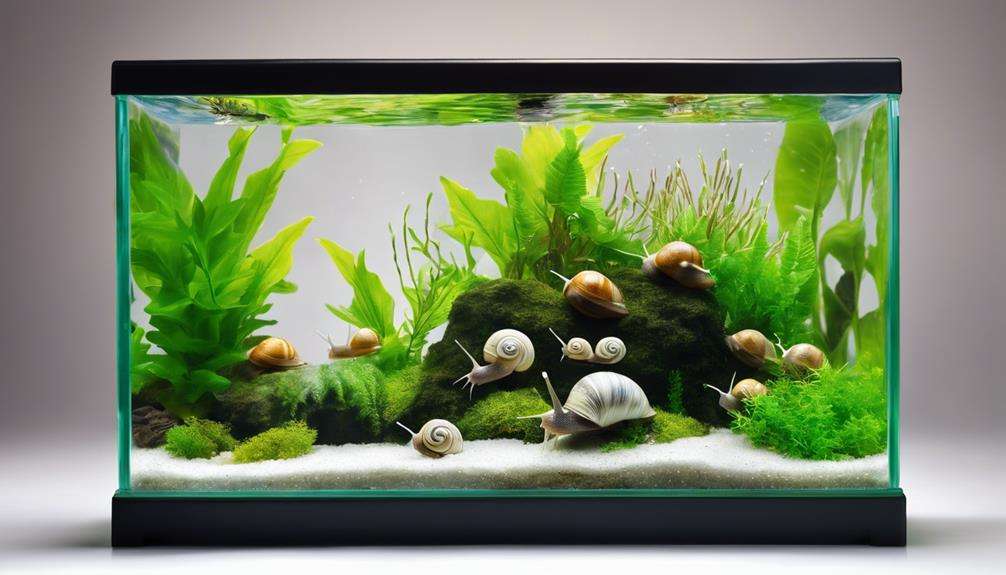
Ensuring a clean and healthy environment for your aquatic snails involves regular tank maintenance to prevent algae buildup and maintain the best water quality.
Cleaning the tank regularly is important to prevent the accumulation of uneaten food, which can lead to water contamination.
Monitoring water parameters such as pH, ammonia, and nitrate levels is vital to guarantee a healthy environment for your aquatic snails.
Utilizing appropriate filtration systems helps keep the water clean and free from harmful substances that can affect the snails' well-being.
Remember to conduct regular water changes to prevent the buildup of waste and maintain a healthy habitat for your aquatic snails.
By removing uneaten food promptly and keeping up with tank maintenance, you provide a clean and healthy environment that promotes the well-being of your aquatic snails.
Maintaining a pristine aquatic environment is key to the long-term health and happiness of your snails.
Handling and Interacting With Your Snail
Maintaining a clean and healthy environment is fundamental for the well-being of your aquatic snails, and proper handling and interaction play an essential role in fostering a positive relationship with these fascinating creatures.
When handling aquatic snails, remember to be gentle and avoid dropping them, as they're delicate and can easily get injured. Snails may retreat into their shells when handled, so exercise patience and allow them time to come out at their own pace. Avoid touching their eyes or antennae, as these are sensitive parts that can be easily damaged.
To interact with your snail, spend time observing their behavior, movement patterns, and feeding habits. Snails may respond positively to being offered food by hand, which can enhance your bond with them. By paying attention to how they move, eat, and behave, you can better understand and appreciate these unique creatures.
Dealing With Common Health Issues
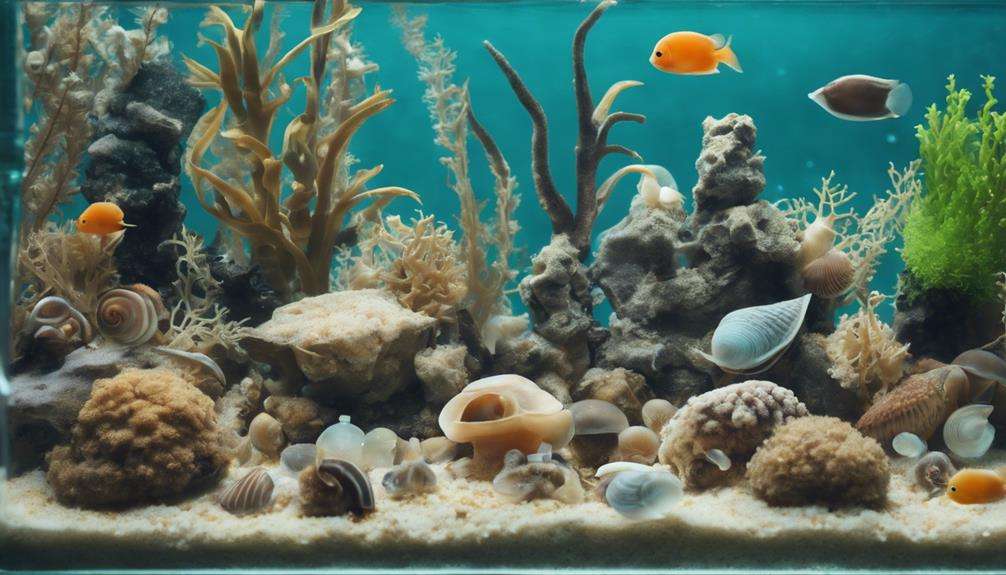
To guarantee the well-being of your aquatic snails, it's essential to promptly address any signs of illness or abnormal behavior that may indicate underlying health issues. Monitor your snails for any changes in behavior, such as lethargy or alterations in appetite, as these can be initial indicators of health problems. Keep a close eye on the condition of their shells; any abnormal discoloration or damage could signal underlying health issues that need attention. Additionally, excessive slime production, beyond what's normal for your snails, may be a sign of stress or disease.
If you notice any sudden population decline or unusual behavior among your aquatic snails, it's important to address these promptly to prevent potential health issues from spreading. Consult with a veterinarian or aquatic expert if you observe persistent health concerns or unusual symptoms in your snails. By staying vigilant and proactive in monitoring your snails for signs of illness or abnormal behavior, you can help maintain their health and well-being.
Frequently Asked Questions
How Do You Keep Aquatic Snails as Pets?
To keep aquatic snails as pets, set up a suitable tank environment with stable water parameters, offer a varied diet, monitor behavior, maintain tank hygiene, consider species-specific care, and guarantee shell health. Breed responsibly and handle with care.
Are Aquarium Snails Easy to Take Care Of?
Are aquarium snails easy to take care of? Indeed, they are low-maintenance pets. Keep an eye on snail behavior, maintain tank setup, adhere to a regular feeding schedule, monitor water quality, follow a cleaning routine, and consider suitable tank mates.
What Do Aquatic Snails Need to Survive?
To survive, aquatic snails need proper water quality, tank size, varied food sources, suitable substrate, temperature control, efficient water filtration, adequate lighting, algae growth for nutrition, tank decorations, and considerations for breeding habits.
Are Snails Hard to Keep Alive in Aquarium?
Keeping aquatic snails alive in an aquarium is like tending a delicate garden. Tank setup, stable water parameters, proper feeding, regular cleaning, suitable tank mates, controlled temperature, shell care, pest prevention, and gentle handling guarantee their well-being.
Conclusion
To sum up, by following these 7 tips for keeping aquatic snails as pets, you can guarantee a thriving and healthy environment for your snail companions. Remember to:
- Choose the right snail species
- Provide a suitable habitat
- Monitor water quality
- Maintain cleanliness
- Handle with care
- Address any health issues promptly
With proper care and attention, your aquatic snails will bring beauty and interest to your aquarium while also contributing to its ecosystem.
